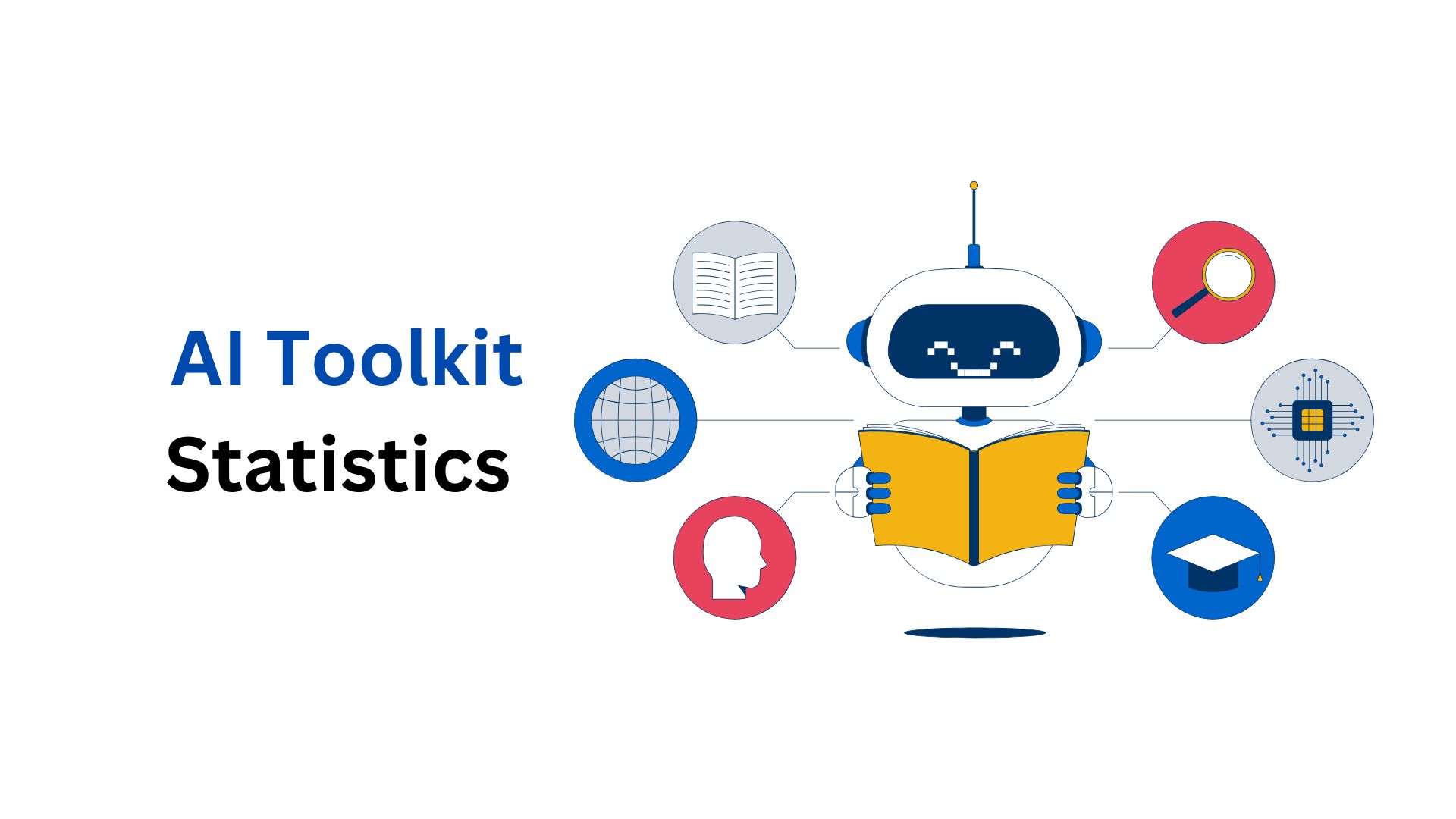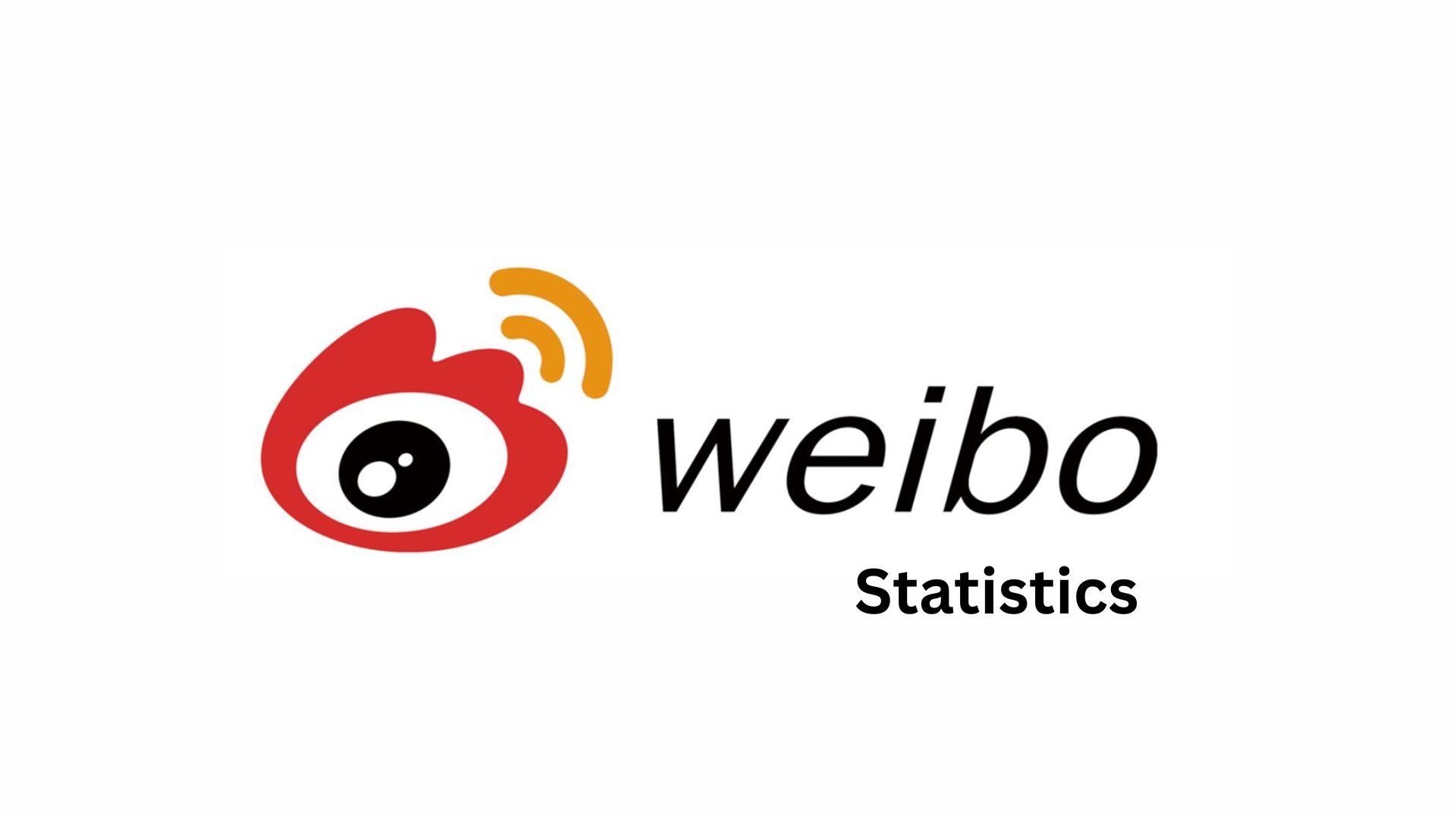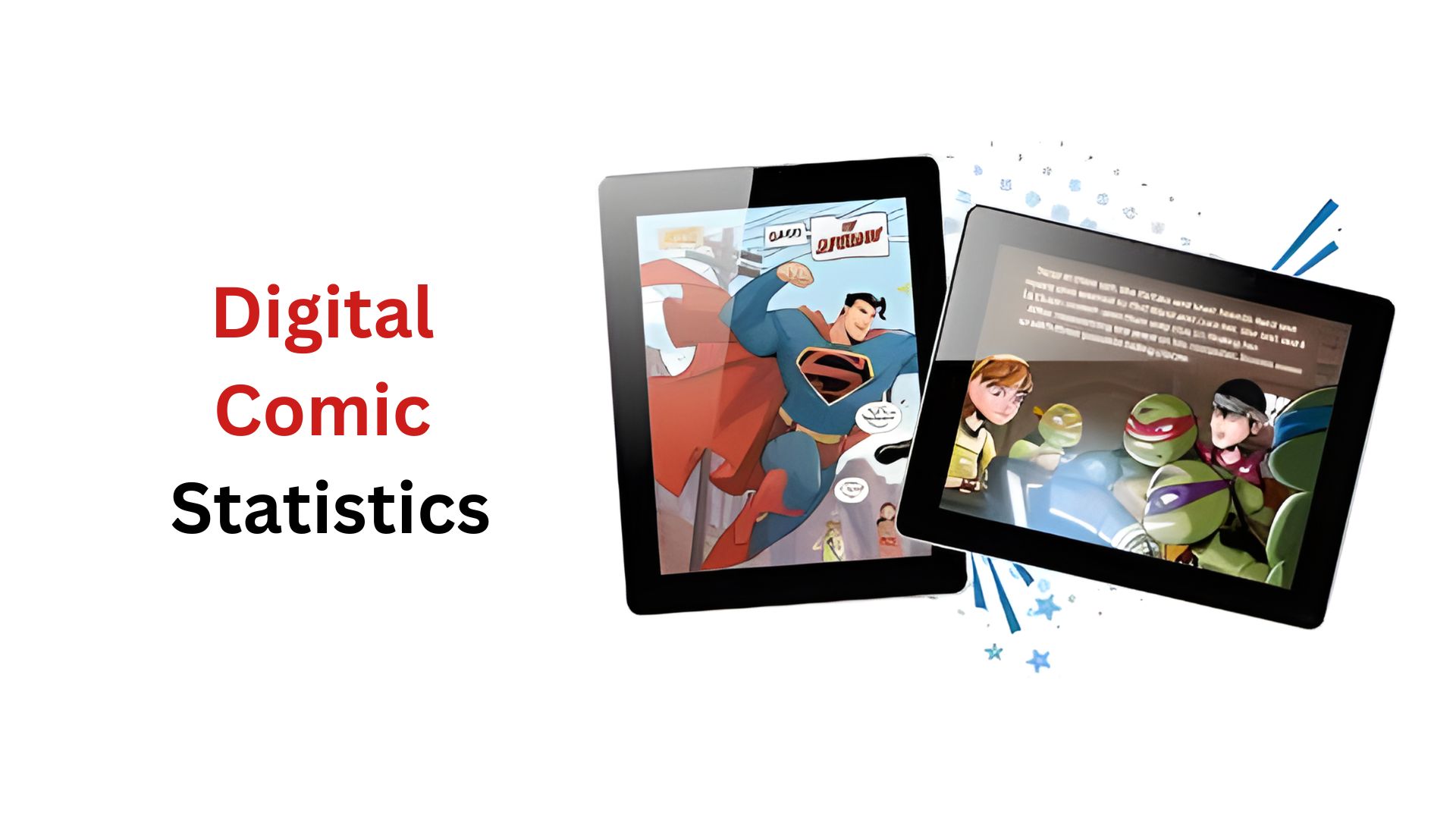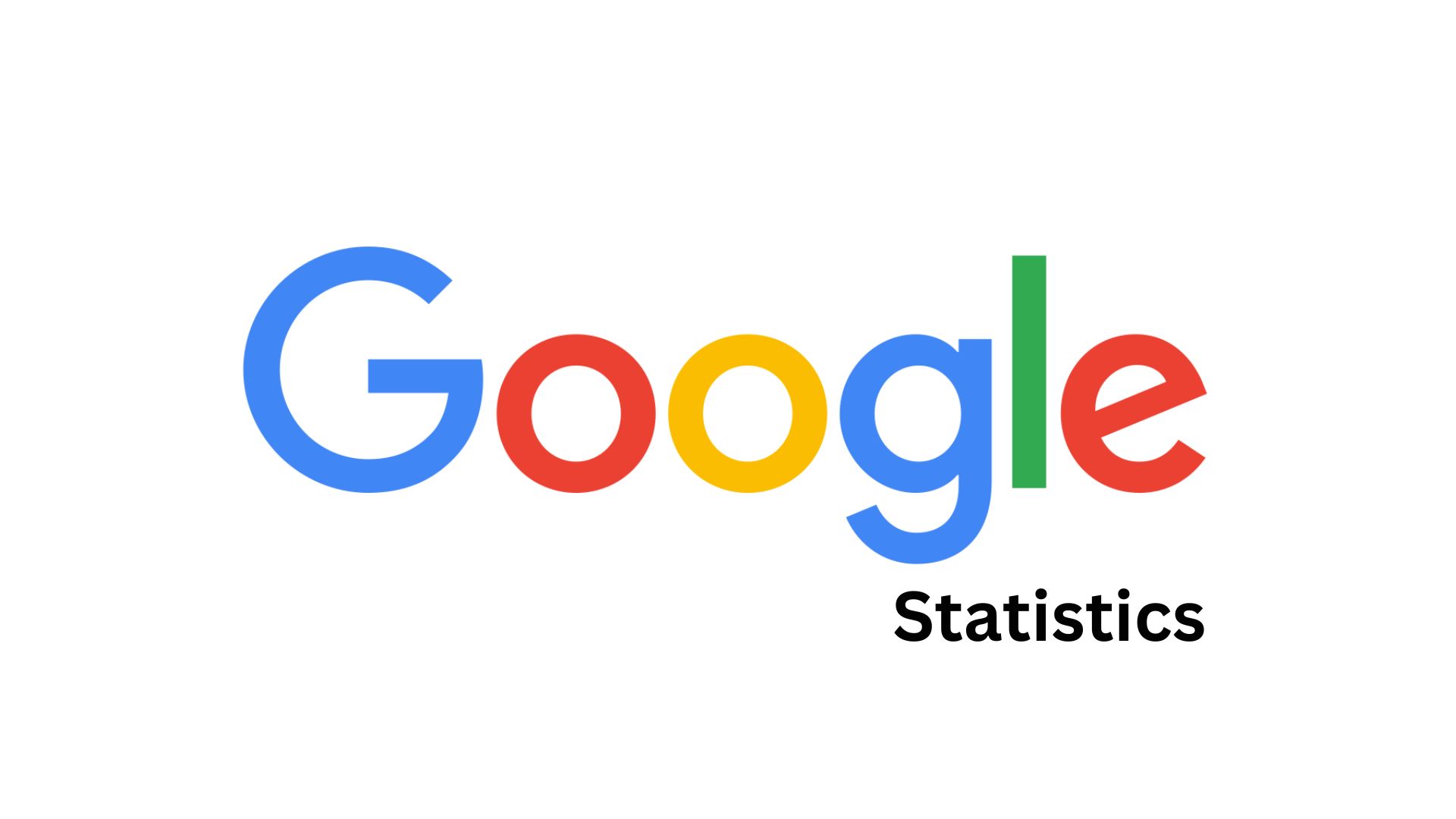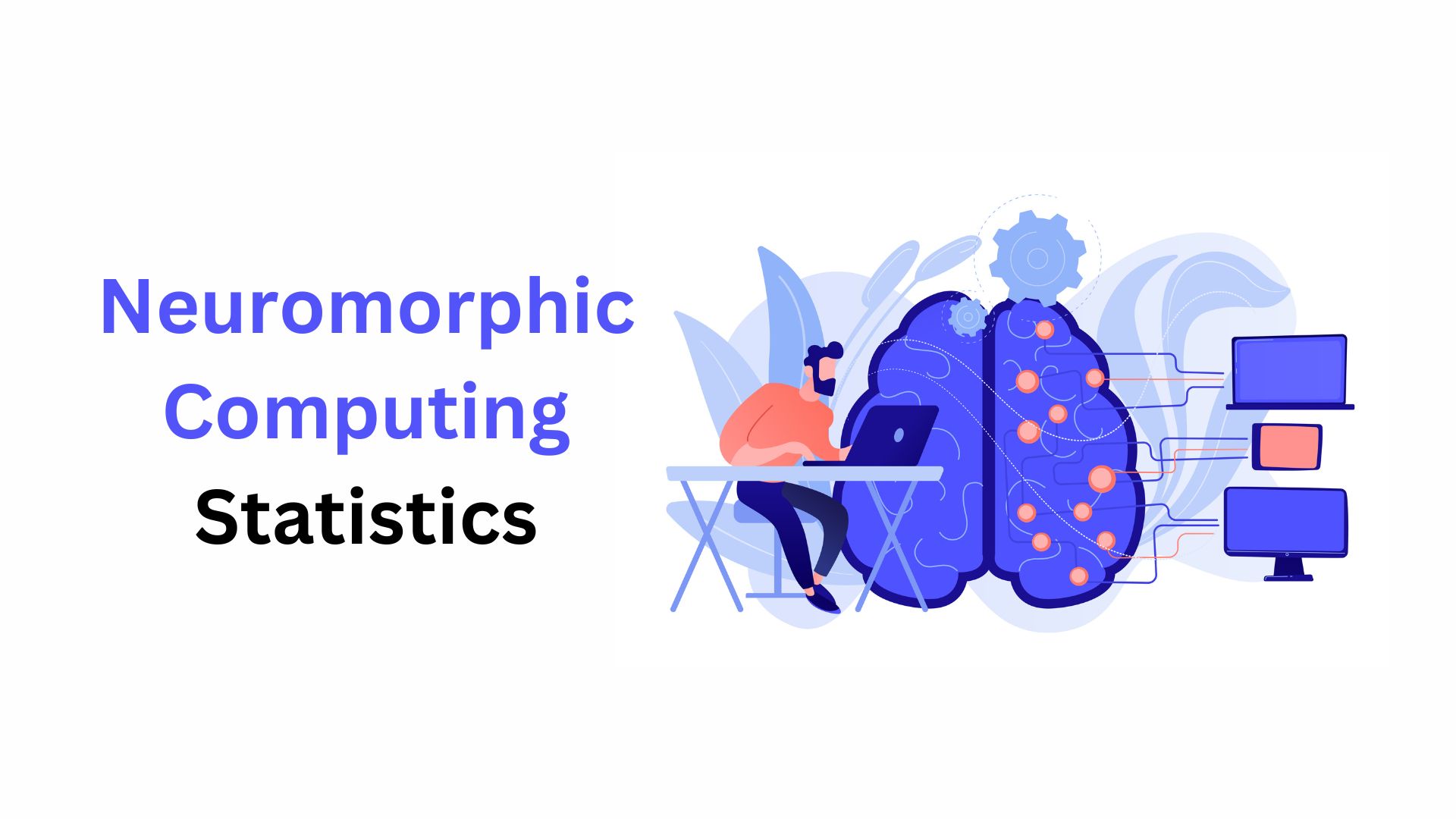Coupon Statistics By Market Size, Demographics And Facts (2025)
Updated · Jul 14, 2025

Table of Contents
- Introduction
- Editor’s Choice
- Coupon Market Size
- Coupon Redemption Rate
- Most Searched For Online Coupon Categories
- Time Spent on Searching Digital Coupons
- Device Usage for Coupon Redemption
- Coupons Influence the Purchasing Behavior
- Social Media Platform Used for Coupons
- Coupon Demographics Statistics
- Conclusion
Introduction
Coupon Statistics: In 2024, the status of digital coupons as sales tools and brand creation remains supreme. Coupons continue to dictate buying trends, be it promo codes, printable vouchers, or cashback offers. Couponing has become much faster and efficient since the advent of mobile applications, social media marketing, and e-commerce platforms. Digitally, promotions are heavily funded by businesses, and consumers are rewarding them with high engagement and conversion rates.
This article presents an in-depth perspective on the latest coupon statistics of 2024, backed by real data from trustworthy sources.
Editor’s Choice
- This digital coupon market is fast-growing and will rise to about US$8.96 billion in 2024 and hence US$34.43 billion in 2032.
- Facebook remains the number one social platform where people discover coupons (42%), and it is trailed by Instagram (30%) and YouTube (25%).
- Coupons influence shopping decisions as 82% of Millennial parents say they govern purchases, while 75% of all parents agree.
- A behavioral change happens with coupons, as 67% of the shoppers tend to execute an unplanned purchase with coupons, and in addition to this, coupon users also tend to spend 35% more on average.
- Gender preferences show women leaning toward the use of coupons for clothes and cosmetics, whereas men tend to find coupons for electronics and appliances more useful.
- Almost 60% of the consumers find digital coupons within 10 minutes, which stresses the need for quick and easy access.
- A coupon typically enjoys a redemption rate of approximately 0.9%, and only going above 7% is when you have good digital campaigns.
- Going by the demographics, 89% of the Millennials and 86% of Gen X always try to use a coupon to try out a new brand, while nearly 96% of the Baby Boomers (also coupon users) mostly prefer paper coupons.
- 86% of online shoppers are willing to give a new vendor a trial when a coupon is offered, while a huge 93% go back to the retailer for regularly offered discounts.
- In 2024, 890 million coupons were redeemed, with 91 billion being distributed, which indicates a notable efficiency given that volume levels were otherwise down.
- Mobile coupon redemptions seem to rule all, as over 90% of the consumers are redeeming offers on their smartphones in 2024.
- Mobile coupons are urging customers 10 times more than paper coupons, reflecting a great convenience and digital-first approach.
Coupon Market Size
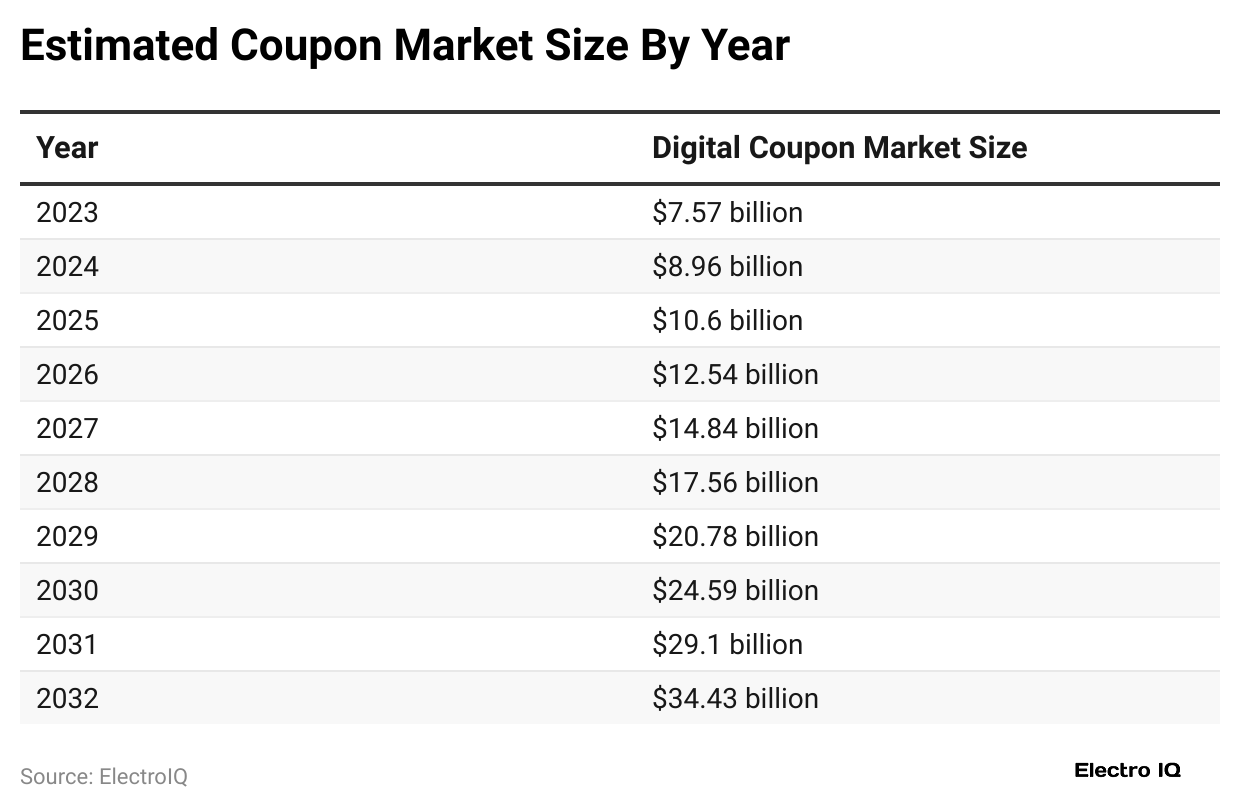
- As per Demandsage, coupon statistics show that in the digital coupons market, steady growth is significant. At US$7.57 billion, the market size was set in 2023.
- Going into 2024, the market size increased to US$8.96 billion, maintaining an appreciable year-over-year growth. Therefore, projections suggest this trend might continue going forward.
- Marketers predict an enviable growth for the market, which will hit US$10.6 billion in 2025, growing to US$12.54 billion in 2026.
- The year 2027 is forecast to witness the market growing up to US$14.84 billion, which will likely pass the mark of US$17.5 billion in 2028. 2029 will see the number rise to US$20.78 billion, with 2030 hitting a crisp US$24.59 billion.
- This digital coupon market is said to reach US$29.1 billion in 2031 and grow to US$34.43 billion in 2032. Thus, these numbers indicate the rising consumers’ dependence on digital discounts and the growing use of mobile and app-based coupon platforms worldwide.
Coupon Redemption Rate
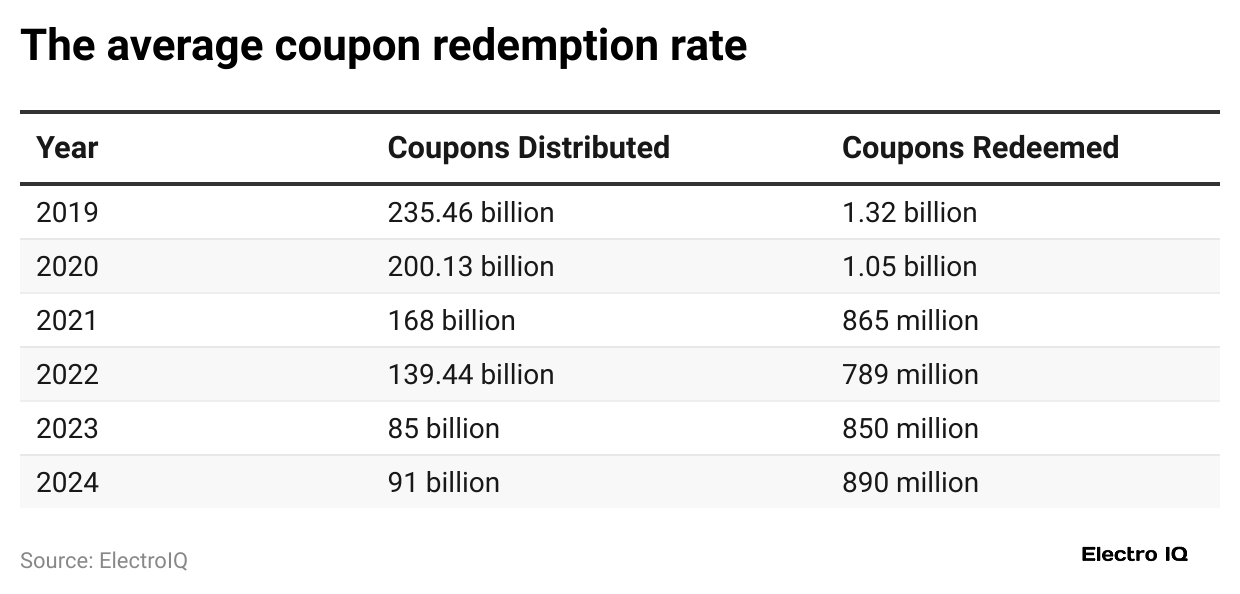
- As per Grabon, coupon statistics state that the coupon redemption rate averages about 0.9% in 2025. What it means is that roughly only 9,000 coupons out of the million coupons distributed by a corporation would be redeemed. While the figure looks low, it should, however, be mentioned that the redemption value for digital coupons is far above that of paper coupons.
- Convertible sentences emphasise the fact that mobile coupons are redeemed approximately 10 times more than paper coupons, mainly because of their simplicity, accessibility, and integration with shopping applications.
- Historically, there has been a decline in the number of coupons distributed per year, but there has been a somewhat constant rate in terms of redemption.
- In 2019, about 235.46 billion coupons were distributed, out of which only 1.32 billion were redeemed. In 2020, the distribution dropped to 200.13 billion, while redemptions dropped to 1.05 billion. This downward trend was sustained in 2021 and 2022, with distributions of 168 billion and 139.44 billion coupons, respectively, and redemption fell to 865 million and 789 million.
- However, a drastic change occurred in 2023 and 2024. Even though only 85 billion coupons were distributed in 2023, redemption numbers climbed back to 850 million, and in 202,4, with 91 billion distributed, redemption numbers rose to 890 million. This is a sign of growing efficiency of digital coupon campaigns as they are more targeted, so the consumers are likely to respond to them.
- Redemption rates vary depending on several factors, such as industry, target audiences, and timing of the offer.
- While the general redemption rate is less than 1%, a digital coupon campaign with redemption rates of 7% or above is considered widely successful.
- It proves that well-placed digital coupon retailer efforts, especially in mobile-first campaigns, reap high returns with greater consumer engagement.
Most Searched For Online Coupon Categories
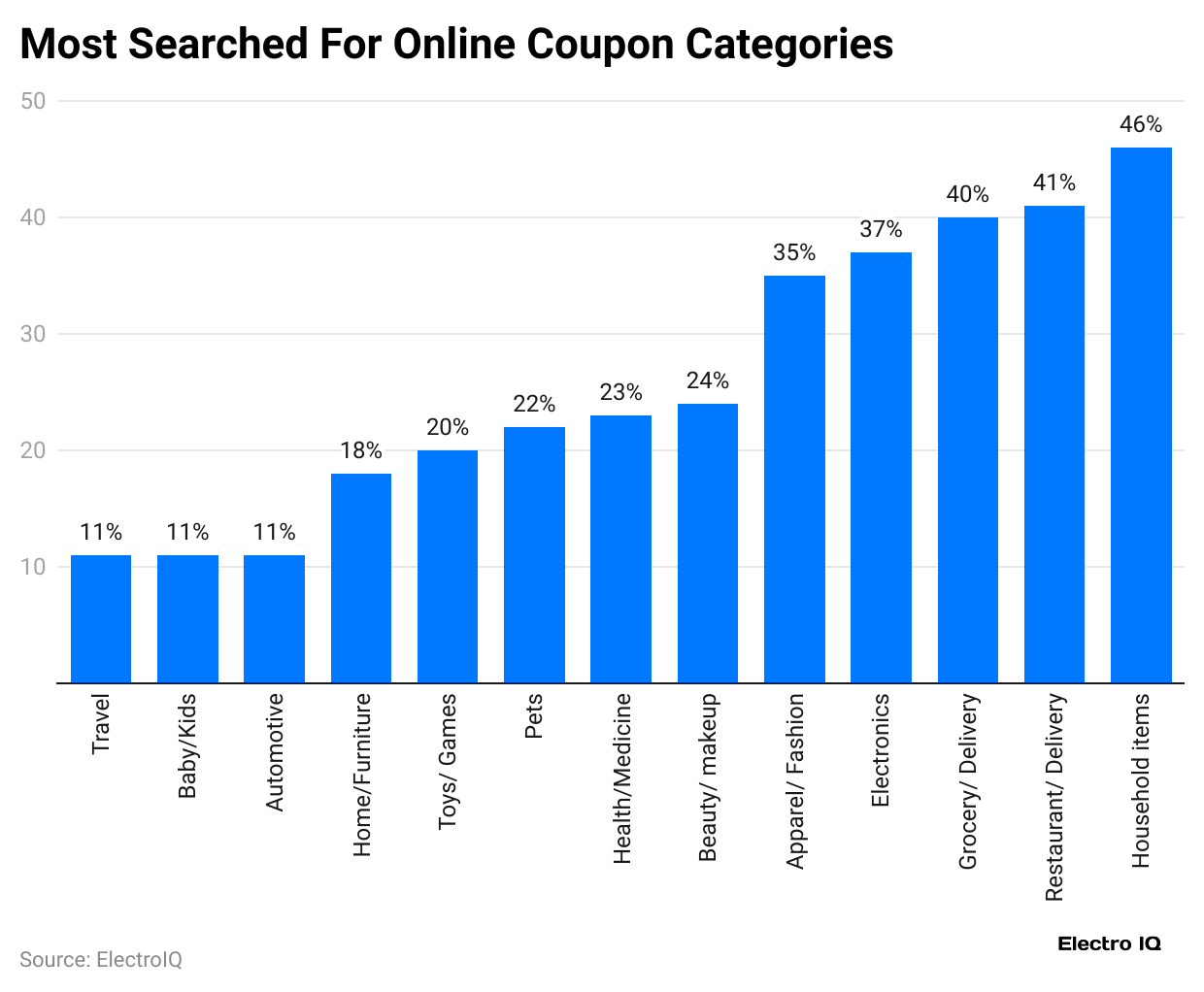
- By 2025, the average redemption rate of coupons is about 0.9%. In other words, if a company distributed 1 million coupons, one could expect 9,000 to be redeemed.
- While those numbers might seem on the lower side, it is always important to remember that digital coupons do better than traditional paper coupons; Mobile coupons can be redeemed at rates that are 10 times higher than paper coupons because of their ease and convenience, accessibility, and their integration with shopping apps.
- Looking at these trends over the years, we see a decrease in the number of coupons printed and distributed, but a somewhat steady trend in actual redemptions: Around 235.46 billion coupons were distributed in 2019, with 1.32 billion redeemed.
- Distributions then dropped to 200.13 billion, with redemptions down to 1.05 billion in 2020.
- Continuing with the downward trend, 2021 and 2022 witnessed the distribution of 168 billion and 139.44 billion coupons, respectively, with the number of redemptions falling back to 865 million and 789 million.
- However, a perceptible change occurred in the years 2023 and 2024, in a good way: in 2023, though only 85 billion coupons were distributed, redemptions boosted back to 850 million, and in 2024, 89 million redemptions were recorded despite 91 billion distributed.
- This trend is reflective of the growing efficiency of digital coupon campaigns, targeted more finely and poised for immediate action from consumers.
- Several factors can affect the redemption rates, including the industry, target audience, and timing of the offer.
- With the overall redemption rate being under 1%, any digital coupon campaign that achieves a redemption rate of 7% or more is generally deemed highly successful. This demonstrates that highly effective digital coupon strategies, especially mobile-first campaigns, can bring higher returns and much higher engagement.
Time Spent on Searching Digital Coupons
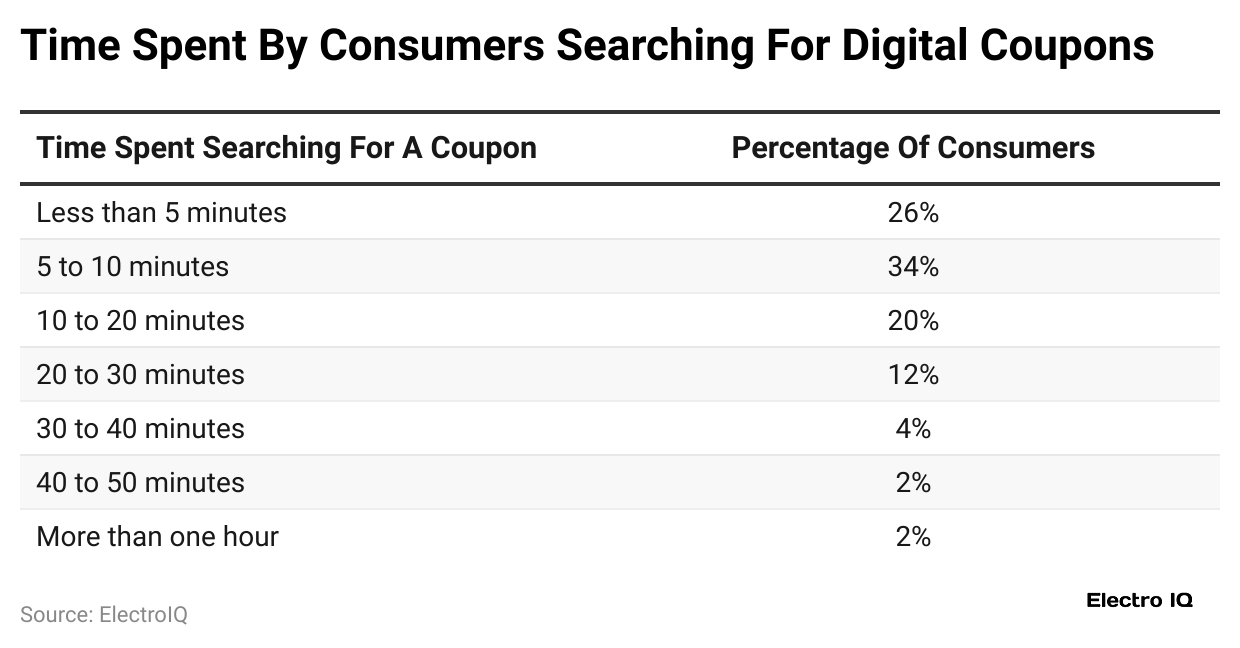
- Consumers differ widely as to how much time they spend hunting for digital coupons; however, most of them are out to work fast and find deals efficiently.
- About 26 % of consumers spend less than five minutes looking for a coupon, while 34 %-the majority-spend anywhere from 5 to 10 minutes. This implies that 60 % of users get what they want in less than 10 minutes, clearly showing these users’ preference for convenience and fast access to discounts.
- Another 20 % of the consumers spend more time searching, from 10 to 20 minutes, so they are, in fact, being a bit more deliberate or comparing more options. There is a steady decline in the %age of users as the cost in time increases.
- From 20 to 30 minutes, only 12 % spend their time, and from 30 to 40 minutes, 4 % of them are still out there searching.
- Very few people are willing to go beyond that. Only 2 % give search 40 to 50 minutes, and another 2 % will spend even more than an hour.
- Therefore, this underlines the importance for branded merchants and retailers to ensure coupons can be easily found and applied at checkout during their shopping journey.
Device Usage for Coupon Redemption
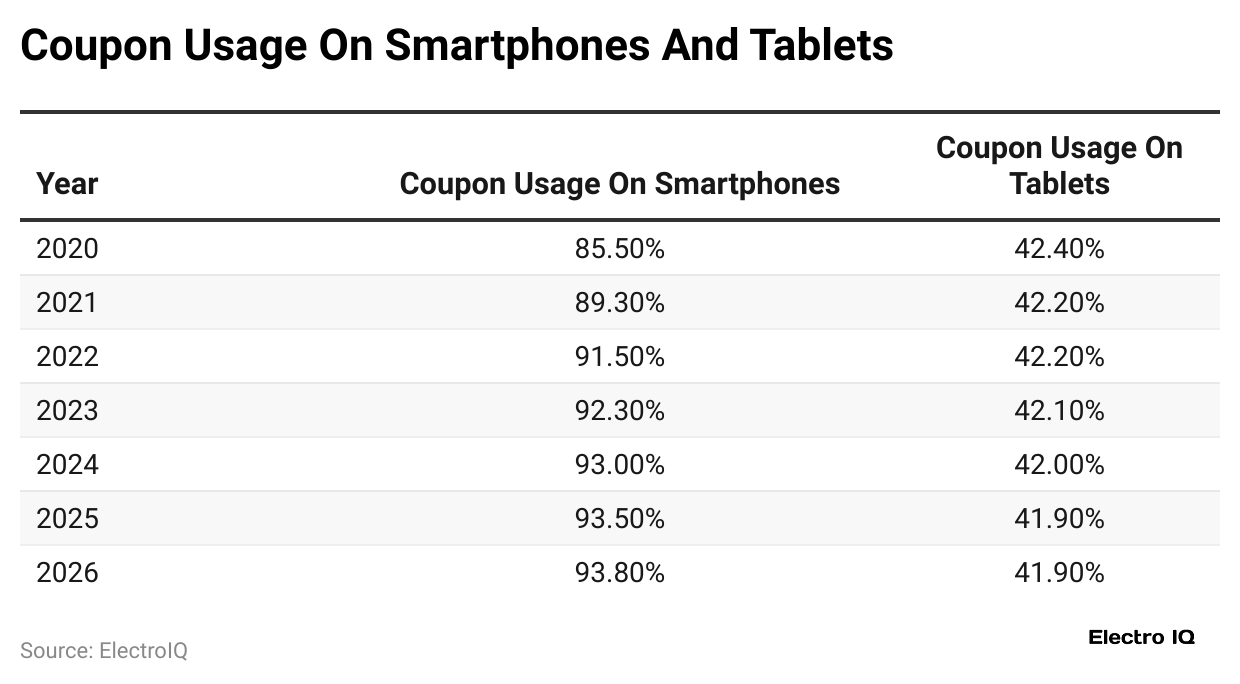
- Mobile devices have grown as the primary channels for redeeming digital coupons. More than 9 in 10 consumers were expected to initiate redemption via smartphone in 2024, witnessing a big jump in comparison to the previous years. There are, for example, statistics from previous years that showed 85.5% of customers doing so through their mobile devices.
- On the other hand, the integration of coupons with shopping apps and mobile wallets has stroked the convenience, speed, and user experience such that the mobile has now become the favourite digital savings platform. Parallel to this growth, the global mobile coupon market is also flourishing.
- Valued at US$1.12 trillion in 2023, the market showed strong momentum until it clocked US$1.42 trillion by 2024. This momentum will keep on growing, with the CAGR estimated at a touch under 11%, precisely 10.8%, during 2024-2032.
- If they keep this pace, the market for mobile coupons will be able to grow almost by a factor of two, reaching close to US$2.9 trillion by the end of the period.
- The statistics here convey how mobile-first strategies are no longer optional for brands-they are essential in engaging today’s digital-worthy consumer.
Coupons Influence the Purchasing Behavior
- Coupons have a tremendous effect on the purchase decision-making behavior of the consumer, especially nowadays with everything being digital.
- An astounding 86% of online shoppers say that if they are offered a coupon, they will be more willing to try a new business, exposing just how powerful discounts can be in attracting first-time customers.
- Up to 80% of shoppers are also willing to work hard to ensure they get the best discount. For many, it’s more than a financial transaction: 40% claim they feel “smart” after procuring that sweet deal. Coupons also influence consumer behaviour in terms of how much they spend.
- Nearly 4 in 10 people end up purchasing more than they had originally planned when using coupons.
- More so, 67% of shoppers confess to going on a shopping spree because they had coupons; hence, coupon users typically spend 35% more than shoppers who do not utilise coupons. This means coupons save the consumer some discounts, yet elevate the overall expenditure.
- Coupons also influence the brand choice of consumers; roughly 29 % have confessed to buying a brand they would not otherwise buy just because there was a coupon to go along with the purchase.
- On the loyalty side, if the retailer always offers good deals and discounts, 93% of consumers say they will most probably return to the retailer.
- Price also contributes greatly to shopping cart abandonment. About 75% of American shoppers who abandon online carts give pricing and the lack of coupons as their main reasons for doing so.
- More than 65% of consumers note that getting a great deal matters more than getting excellent customer service; the power of pricing incentives as a deciding factor in shopping cannot be overrated.
Social Media Platform Used for Coupons

- As per a Statista report, coupon statistics state that in the U.S., Facebook is the most popular social media site for finding promo codes, discounts, and coupons, with 42% of shoppers using it as such.
- With this level of reach and the ease with which one can share and get access to promotional posts from brands, it is indeed the channel of choice among deal seekers.
- Instagram ranks second, with 30% of consumers flocking to this platform, mostly lured by influencer promotions and brand stories advertising time-bound offers.
- YouTube comes next, with 25% of shoppers, where discount codes are shared by creators either during product reviews or in sponsored segments.
- Facebook Groups occupy an important place, with 18% of users looking for deals through community posts and discount-curating threads.
- Twitter and Pinterest, in that order, present 14% and 13% of shoppers looking out for flash sales and product-specific discounts.
- TikTok and Reddit tie at 12%, implying that short-form videos and community discussions are becoming increasingly important for coupon discovery, at least toward the younger demographic.
- Snapchat experiences very little coupon activity, with just 8% of users looking for discounts on it. As expected, LinkedIn fares the least, with only 6% of users going there looking for coupons.
Coupon Demographics Statistics
- Coupons have impacted the buying behaviour of the various age groups and genders.
- As per a Statista report, coupon statistics indicate that about 89% of Millennials state that if they got a coupon, they would try a new brand, showing how much discounts influence the younger clients to get attracted.
- Following closely behind are Generation X, with 86% willing to try new brands when presented with a coupon. More of a Labbies approach towards brand purchase, with 78% of them willing to switch brands, and Baby Boomers being more brand loyal, 76% of them willing to switch under the influence of a discount.
- Social media has great power in the coupon landscape, especially for Millennials. About 90% of them share deals; 43% share them over social media.
- Millennials use mobile devices when hunting for deals, with 70% of them looking for coupons on their phones. This mobile trend has had the impact of 20% less search for coupons from desktops.
- Around 96% of Baby Boomers in the U.S. use coupons. Most of them still prefer paper coupons (70% usage), followed by online coupons (32%) and mobile coupons (17%). Gender differences also influence coupon behaviours.
- As per Retail Dive, while 48% of the women in the U.S. download digital coupons on their smartphones during in-store shopping, only 35% of the men do the same.
- On the other hand, men using their phones to compare prices while shopping outnumber women, with 63% and 46%, respectively.
- Around 73% of females apply coupons for clothing and accessories, and 63% for cosmetics and personal care.
- Men appear more inclined to use coupons on apparel. Only 52% apply coupons to personal care items.
- They are more inclined to apply coupons for foods and food delivery services (64%), with a very distinct preference toward electronics (63%) as compared with 41% of women.
- Coupons are used for household appliances by 48% of men as against 35% of women.
- As per Valassis, with shoppers who have been using coupons for some time, especially Generation Xers, 80% include coupons in their shopping trip planning list.
- Overall, 75% of shoppers use coupons to plan their purchases, regardless of age. Coupon campaigns also greatly influence purchasing decisions; for example, 82% of Millennial parents claim that the receipt of a coupon aids in their decision to purchase a product.
- Generally, 60% of all shoppers interviewed agree that coupons or discounts actually speed their decision to purchase, and 75% of parents in general agree, reinforcing how persuasive a well-timed reward can be.
Conclusion
Coupon Statistics: Couponing has increasingly become a complete art of customer strategy by now, servicing consumers, as it was meant to do so, and the merchants. Digital coupons are more powerful than ever, with over 145 million users in the U.S. alone and mobile adoption scaling all over the world. Brands employing personalised, app-based, and social-integrated promotions reap higher engagement, loyalty, and revenues.
The future of coupon marketing looks even more capable and larger in outreach with further development in AI and mobile technologies. From the standpoint of modern marketers and businesspeople, staying abreast is not an option but an absolute necessity for growth.
FAQ.
In the year 2024, some US$8.96 billion was generated from the sale of digital coupons, up from US$7.57 billion in 2023. The market is a fast-rising market and will hit US$34.43 billion by the year 2032, with the increased adoption by consumers of mobile and app-based couponing platforms.
The average redemption rate for coupons in 2024 is around 0.9%, but mobile and digital coupons can record rates upward of 7% when promoted well. Mobile coupons have higher levels of redemption–up to 10 times higher than paper coupons–primarily due to greater accessibility and ease of use.
Some of the major impacts coupons have on consumer behaviour include: 67% of shoppers make spontaneous purchases when they have coupons. Coupon users spend 35% more than their counterparts who do not use coupons. 86% of online shoppers become more tempted to try a new business when offered a coupon. 93% of consumers would likely return to a retailer that offers regular discounts.
As much as 90% of consumers use smartphones for redeeming digital coupons, thus making mobile devices the dominant platform. Alongside social media, other platforms will also generate leads for coupons: 42% of the coupon seekers use Facebook, 30% turn to Instagram, and 25% look for coupons on YouTube.
Millennials (89%) and Gen X-ers (86%) are highly apt to try new brands because of coupons. About 96% of Baby Boomers use coupons-they’re mostly paper coupons. Women use coupons mainly for apparel (73%) and beauty products (63%), whereas guys use coupons mainly for electronics (63%) and food delivery (64%). 75% of parents say their buying decisions are influenced by coupons.

Maitrayee Dey has a background in Electrical Engineering and has worked in various technical roles before transitioning to writing. Specializing in technology and Artificial Intelligence, she has served as an Academic Research Analyst and Freelance Writer, particularly focusing on education and healthcare in Australia. Maitrayee's lifelong passions for writing and painting led her to pursue a full-time writing career. She is also the creator of a cooking YouTube channel, where she shares her culinary adventures. At Smartphone Thoughts, Maitrayee brings her expertise in technology to provide in-depth smartphone reviews and app-related statistics, making complex topics easy to understand for all readers.

